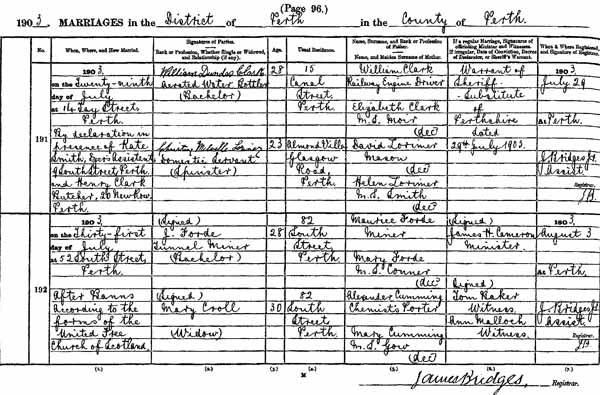Statutory Register of Marriages
Statutory Register of Marriages
The Statutory Register of Marriages contains detailed information about each couple who have married in Scotland since 1 January 1855 and is of great value to researchers. This guide covers:
- Information recorded in the register
- Age at marriage
- Prohibited degrees of relationship
- Regular and irregular marriages
- Divorce
Information Recorded in the Register
Most records include:
- when, where and how married
- names of parties
- occupation of bride and groom
- whether parties were single, widowed or divorced
- their ages
- addresses of bride and groom
- name, surname and occupation of father
- name and maiden surname of mother
- signature of witnesses
- where the marriage was registered and signature of registrar.
In 1855 entries you will also find information about the place and date of birth of both parties; the number of any children by former marriages (whether living or dead); and the number of previous marriages (if any).
From 1965 onwards the date of birth of both parties, addresses of witnesses and occupations of the mothers of the bride and groom has been recorded.
Here are some examples of how the Statutory Register of Marriages can help you continue your research in the birth, death, marriage and census records.
- age at marriage helps you to estimate the year of birth
- names of both parents' (including the mother's maiden name) can be used to ensure that you identify the correct birth entry
- usual residence is useful for narrowing down searches in the nearest census(es).
In the second entry in the example below the bride is described as a widow. Her father’s surname is recorded and is her maiden name. You can use this information, together with both her parents’ names, to trace her earlier marriage.
Regular and Irregular Marriages
In the 1903 register of marriages for the registration district of Perth most couples married regularly after publication of banns according to the forms of the Church of Scotland (or of a different denomination). This page from the register has an example of an irregular marriage (the first entry) and of a regular marriage according to the forms of the United Free Church of Scotland (the second entry).

The irregular marriage was by declaration in front of two witnesses at an address in Perth (column one). Column six records that the couple obtained a warrant from the sheriff substitute of the county to enable them to register their marriage officially. Such irregular marriages were abolished by provisions in the Marriage (Scotland) Act 1939. The Act also allowed for civil marriages to take place in registration offices.
For information about marriages at Gretna Green, Lamberton Toll and Coldstream please go to our research guide on Irregular Border Marriage Registers.
Age at Marriage
You won't find the term "of full age" because the exact age (as reported to the registrar) is recorded in the Scottish marriage registers. It was legal for girls of 12 years and boys of 14 to marry up to 1929 although it is thought that marriages at such a young age were rare. You can find out more about what was and is the minimum age for marriage in Scotland? in the Registration area of this website.
Prohibited Degrees of Relationship
It is illegal to marry someone who is closely related to you. Details are provided in tables of “forbidden degrees of kindred and affinity” which have separate columns for men and women. For example, a man may not marry:
- his grandmother, aunt, mother, daughter and sister (his kindred)
- his wife’s brother’s daughter and his daughter’s son’s wife (who are related by affinity).
There are approximately 30 prohibited degrees of relationship altogether.
Divorce
Divorces in Scotland prior to 1984 of a couple who had married in Scotland were recorded in the Register of Corrected Entries (later the Register of Corrections, Etc). A cross-reference to the RCE was added to their entry in the Statutory Register of Marriages. The Statutory Register of Divorces was introduced in 1984.